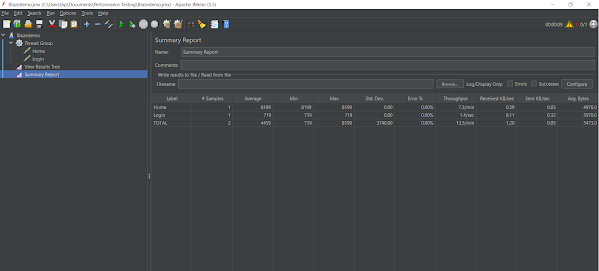Working with Listeners
Listeners:
As a sampler component of JMeter runs, listeners give a visual representation of the information obtained about those test cases by JMeter. It makes it easier for the user to read sampler results in some log files in the form of tables, graphs, trees, or plain text.
JMeter offers about 15 listeners, but the most used ones are table, tree, and graph.
1) View Result Tree:
The View Results Tree is primarily a tool for troubleshooting the sent and received requests and responses. It's useful to check to see if the script is running appropriately.
2) Summary Report:
Let's do the following analysis of the Test plan summary report now.
- Label: It is the URL or name of the specific HTTP(s) Request. The Thread Group name, which is a prefix of each and every name, needs to be chosen in this case as a suitable name for the label.
- Samples: This shows the quantity of virtual clients for each demand.
- Average: It is the average amount of time required by each example to execute an explicit mark.
- Min: The term "Min" refers to the quickest possible response to an HTTP request.
- Max: The duration of an example that makes the largest difference for the explicit mark.
- StdDev.: This illustrates the layout of exceptional cases that deviated from the typical value of test reaction time. The lower this esteem, the more consistent the information. The standard deviation should be half of the average time for a name or less than that.
- Error%: For each and every label, it is used to display the failed requests.
- Throughput: The quantity of requests handled by the server per unit of time (seconds, minutes, or hours) is known as throughput. This period of time is measured from the start of the first example to its outermost bound. Greater throughput is preferable.
- Response Time: It is used to demonstrate how much is required to display the result.
- KB/Sec:
This demonstrates the volume of data downloaded from the server during the execution of the presentation test. The throughput is calculated in Kilobytes per second.
3) Aggregate Report:
They are nearly identical, with the exception that the aggregate report includes the median, 90% line, etc. Because of this, aggregate reports use up more RAM while summary reports use up less.
- 90% Line (90th Percentile): This line represents the time that 90% of the samples took, exactly. It took at least as long for the 10% of the remaining samples.
- 95% Line (95th Percentile): This is the time that 95% of the samples took, on average. It took at least as long for the final 5% of samples.
- The 99% Line (99th Percentile) indicates that 99% of the samples took NO LONGER THAN THIS TIME. It took at least as long for the 1% remaining samples.
4) Graph Result:
High-level information is provided by this listener, but it can only be used in summary form. The number of samples includes the number of transaction controllers as well, so it does not give a precise request count. The lack of a filter option degrades this listener.
High-level information is provided by this listener, but it can only be used in summary form. The number of samples includes the number of transaction controllers as well, so it does not give a precise request count. The lack of a filter option degrades this listener.
5) View result in table:
The "View Results in table" listener, as its name implies, displays the data in table form, that is, in rows and columns. It is a widely used listener and offers crucial data for analysis. For each sampler, the data is presented in table form. As it uses a lot of CPU and memory, this listener cannot be utilized for comprehensive load assessment.
.png)





Comments
Post a Comment